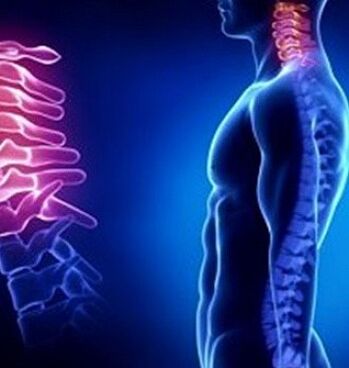
With osteochondrosis, there is a gradual destruction of spinal tissue, which leads to a violation of its function. Usually such a degenerative process develops in most of its mobile departments. In young people, cervical osteochondrosis is most often observed. The instability of this department, combined with increased physical activity, explains its susceptibility to injury and various dystrophic processes. In 3 out of 10 cases, he is the one who causes the sudden headache. Osteochondrosis causes metabolic disorders in the spine. Because of this, the disc in it protrudes, and then cracks.
symptoms
Some signs may indicate dystrophic changes in the spine. Depending on the stage of the disease, they are more pronounced or weaker. Cervical osteochondrosis has the following symptoms:
- Pain in the neck, neck, shoulders. Strengthens even with a small load.
- Numbness in the limbs.
- Cracks when twisting the neck.
- Headaches are localized mainly in the occiput and temples.
- Fainting, chronic fatigue.
- Noise in the ears, hearing loss.
- Loss of visual acuity.
Cervical osteochondrosis can also be indicated by pulling pain in the heart area. Patients often experience a sensation similar to angina pectoris. When the roots of the spine are pinched, other disorders also occur. For example, loss of sensation of the tongue or decreased neck muscle tone, respiratory problems. If treatment is not prescribed in time, the patient may experience protrusion or hernia.
There are four stages of osteochondrosis. The first is characterized by instability in the intervertebral disc. In the latter, a bulge is considered a major sign. In this case, the gap between the vertebrae becomes smaller. There is a pain syndrome, which may be associated with pinched nerve roots.
In the third stage, destruction of the fibrous ring, which is part of the intervertebral disc, occurs. That is why it then changes shape. A patient with stage four cervical osteochondrosis felt severe pain with any movement. It should be noted that a decrease in its intensity does not indicate a recovery. On the contrary, this indicates that the process of osteophyte formation that connects the vertebrae has begun. As a rule, this leads to defects. Treatment is prescribed based on clinical signs and stage of pathological development.
The cause of the disease

Sedentary work is most often accompanied by cervical osteochondrosis. This part of the spine is quite dense, and therefore even a slight muscle tension in it leads to compression of the nerve endings and blood vessels. Against this background, osteophytes often form, which only worsen the condition. In addition to an inactive lifestyle, the disease can be triggered by:
- metabolic disorders;
- Malnutrition;
- salt deposition in the cervical spine;
- hypothermia;
- hereditary tendencies;
- cervical spine injury;
- joint pain.
The cause of the development of this disease can also be curvature of the spine or overweight. Risk groups include people with poor physical fitness or athletes who make mistakes in the training process.
Which doctor treats cervical osteochondrosis?
To prevent the development of complications at the first signs of pinching the spinal nerve roots, you should seek help from a physician. Cervical osteochondrosis and its symptoms are treated by neurologists, chiropractors, osteopaths.
In addition, you may need to consult a neurosurgeon, traumatologist, therapist, cardiologist. To differentiate the diagnosis, the doctor analyzes the patient’s complaints. At this stage, he asks the patient the following questions:

- When did neck pain first appear?
- Do other symptoms accompany cervical osteochondrosis?
- Is the patient’s professional activity associated with lifting weights or maintaining the neck in an immobile position for long periods of time?
- What is the patient's fitness level?
- Does the patient have signs of nerve disorders?
To assess the condition of the spine, the doctor prescribes an x-ray, CT or MRI. Depending on the symptoms and stage of the disease, treatment may include massage, swimming, and exercise therapy. The process of local destruction is influenced by acupuncture. With severe pain syndrome, the doctor prescribes an anesthetic. Tension in the muscles is released with muscle relaxants. In further cases, when the patient has a hernia that compresses the spinal cord root, surgical intervention is required.
What if the disease is not treated?
In the absence of qualified medical treatment, patients end up experiencing chronic pain in the cervical spine. It radiates to the top and bottom, which are full of paralysis. When osteophytes grow, they compress nerve channels, veins, and arteries. This can disrupt the circulatory process of the brain. Often this leads to ischemia and stroke of the spine. Patients also have impaired vision, hearing, migraine and vegetovascular dystonia appear.
Studying cervical osteochondrosis and its clinical symptoms, doctors often diagnose radiculopathy. It leads to partial or complete loss of vertebral mobility. The occurrence of an exacerbation is a reason for the patient’s hospitalization. The most severe consequence of cervical osteochondrosis is considered to be spinal cord compression. The risk of death in this case is quite high. To avoid the development of complications, it is necessary to consult a doctor as soon as possible. The way it works should be gentle. Every day you need to do special gymnastics, and if possible, morning exercises.


























